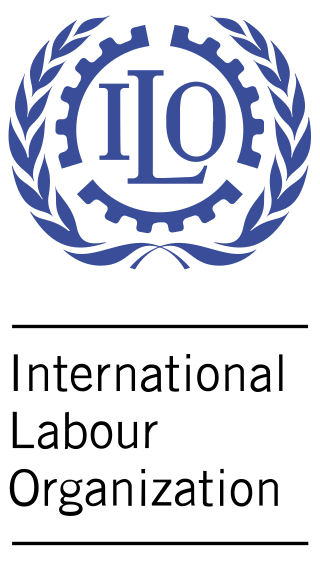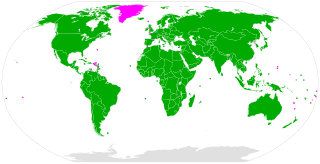
The International Labour Organization (ILO) is a United Nations agency whose mandate is to advance social and economic justice by setting international labour standards. Founded in October 1919 under the League of Nations, it is one of the first and oldest specialized agencies of the UN. The ILO has 187 member states: 186 out of 193 UN member states plus the Cook Islands. It is headquartered in Geneva, Switzerland, with around 40 field offices around the world, and employs some 3,381 staff across 107 nations, of whom 1,698 work in technical cooperation programmes and projects.

The Convention Concerning the Prohibition and Immediate Action for the Elimination of the Worst Forms of Child Labour, known in short as the Worst Forms of Child Labour Convention, was adopted by the International Labour Organization (ILO) in 1999 as ILO Convention No 182. It is one of eight ILO fundamental conventions.

The Forced Labour Convention, the full title of which is the Convention Concerning Forced or Compulsory Labour, 1930 (No.29), is one of eight ILO fundamental conventions of the International Labour Organization. Its object and purpose is to suppress the use of forced labour in all its forms irrespective of the nature of the work or the sector of activity in which it may be performed. The Convention defines forced labour as "all work or service which is exacted from any person under the menace of any penalty and for which the said person has not offered himself voluntarily", with few exceptions like compulsory military service.
The Freedom of Association and Protection of the Right to Organise Convention (1948) No 87 is an International Labour Organization Convention, and one of eight conventions that form the core of international labour law, as interpreted by the Declaration on Fundamental Principles and Rights at Work.
Maternity Protection Convention, 2000 is an International Labour Organization Convention.
The Convention concerning Discrimination in Respect of Employment and Occupation or Discrimination Convention is an International Labour Organization Convention on anti-discrimination. It is one of eight ILO fundamental conventions. The convention requires states to enable legislation which prohibits all discrimination and exclusion on any basis including of race or colour, sex, religion, political opinion, national or social origin in employment and repeal legislation that is not based on equal opportunities.
Workers with Family Responsibilities Convention, 1981 is an International Labour Organization Convention.
Home Work Convention, created in 1996, is an International Labour Organization (ILO) Convention, which came into force in 2000. It offers protection to workers who are employed in their own homes.
Forced prostitution, also known as involuntary prostitution or compulsory prostitution, is prostitution or sexual slavery that takes place as a result of coercion by a third party. The terms "forced prostitution" or "enforced prostitution" appear in international and humanitarian conventions, such as the Rome Statute of the International Criminal Court, but have been inconsistently applied. "Forced prostitution" refers to conditions of control over a person who is coerced by another to engage in sexual activity.

The Convention on the Nationality of Married Women is an international convention passed by the United Nations General Assembly in 1957. It entered into force in 1958 and as of 2024 it has 75 state parties.
Work in Fishing Convention (2007) C 188, was adopted at the 96th International Labour Conference (ILC) of the International Labour Organization ILO in 2007. The objectives of the Convention is to ensure that fishers have decent conditions of work on board fishing vessels with regard to minimum requirements for work on board; conditions of service; accommodation and food; occupational safety and health protection; medical care and social security. It applies to all fishers and fishing vessels engaged in commercial fishing operations. It supersedes the old Conventions relating to fishermen.

The Maritime Labour Convention (MLC) is an International Labour Organization (ILO) convention, number 186, established in 2006 as the fourth pillar of international maritime law and embodies "all up-to-date standards of existing international maritime labour Conventions and Recommendations, as well as the fundamental principles to be found in other international labour Conventions". The other pillars are the SOLAS, STCW and MARPOL. The treaties applies to all ships entering the harbours of parties to the treaty (port states), as well as to all ships flying the flag of state party (flag states, as of 2021: over 97 per cent).
The Conventions concerning Employment of Women during the Night are conventions drafted by the International Labour Organization (ILO) which prohibit women from performing industrial work during the night. The first convention was adopted in 1919 and revised versions were adopted in 1934 and 1948. A protocol to the convention was adopted in 1990 allowing for easing of the restriction under conditions. As of April 2011 the conventions had 27, 15, 46 (undenounced) ratifications respectively. The protocol was ratified 5 and denounced by 2.
The Declaration on Fundamental Principles and Rights at Work was adopted in 1998, at the 86th International Labour Conference and amended at the 110th Session (2022). It is a statement made by the International Labour Organization "that all Members, even if they have not ratified the Conventions in question, have an obligation arising from the very fact of membership in the Organization to respect, to promote and to realize, in good faith and in accordance with the Constitution, the principles concerning the fundamental rights which are the subject of those Conventions".
International labour law is the body of rules spanning public and private international law which concern the rights and duties of employees, employers, trade unions and governments in regulating Work and the workplace. The International Labour Organization and the World Trade Organization have been the main international bodies involved in reforming labour markets. The International Monetary Fund and the World Bank have indirectly driven changes in labour policy by demanding structural adjustment conditions for receiving loans or grants. Issues regarding Conflict of laws arise, determined by national courts, when people work in more than one country, and supra-national bodies, particularly in the law of the European Union, have a growing body of rules regarding labour rights.
The First International Congress of Working Women (ICWW), convened by the Women's Trade Union League of America from October 28 to November 6, 1919, was a meeting of labor feminists from around the world. The ICWW planned to share their proposals for addressing women's labor concerns at the First International Labor Conference (ILC) of 1919. ICWW delegates agreed upon a list of resolutions, some of which were taken up by the ILC's Commission on the Employment of Women and resulted in the passage of the Maternity Protection Convention, 1919.
The gender pay gap in New Zealand is the difference in the median hourly wages of men and women in New Zealand. In 2020 the gender pay gap is 9.5%. It is an economic indicator used to measure pay equality. The gender pay gap is an official statistic published annually by Stats NZ sourced from the Household Labour Force Survey.
Gender pay gap in India refers to the difference in earnings between women and men in the paid employment and the labor market. For the year 2013, the gender pay gap in India was estimated to be 24.81%. Further, while analyzing the level of female participation in the economy, this report slots India as one of the bottom 10 countries on its list. Thus, in addition to unequal pay, there is also unequal representation, because while women constitute almost half the Indian population, their representation in the work force amounts to only about one-fourth of the total.

 Bahrain
Bahrain Brunei
Brunei Cook Islands
Cook Islands  Kuwait
Kuwait Marshall Islands
Marshall Islands Myanmar
Myanmar Oman
Oman Palau
Palau Qatar
Qatar Somalia
Somalia Tonga
Tonga Tuvalu
Tuvalu United States
United States



